Did You Know Old Glass Is Radioactive?
Your home might contain unique uranium-infused radioactive antiques, but are they dangerous?
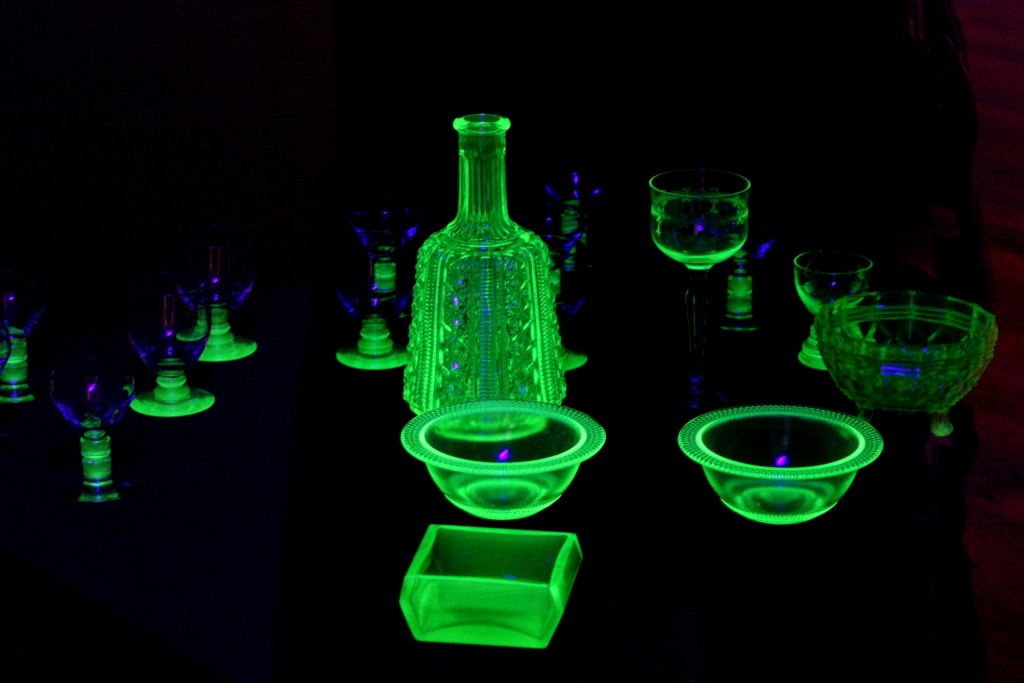
Few people are aware of the many radioactive antiques lurking within their homes. Some of these objects include military compasses, watches, photographic camera lenses, ceramic tiles, tables, lamps, and plates, or as pictured above, the primary object of interest in this article is vintage glassware.
Before we delve into glassware, It’s worth mentioning some radioactive antiques share a similar property and are the primary draw for collectors because of the brilliant glow they give off. Not all radioactive antiques glow, but some do (or did). Antique compasses and watches, for example, were painted with radioluminescent paint to be viewed in dark settings. Many dials in watches and compasses from the 1920s were painted by the infamous ‘Radium Girls’, who suffered significant and deadly health effects from continued direct skin exposure and ingestion of the dangerous paint containing Radium-226. Radium continued to be used until 1970.
Most of the remaining radium-laced objects have lost their glow because of radioactive decay ‘burning out’ the luminescent properties of the paint. Though, some examples may still fluoresce under blacklight. Whether or not they retain their glow, they remain notably radioactive, with a half-life of 1600 years.
But not all radioactive objects incorporate radium. Fiestaware is a brand that produced kitchenware glazed with uranium, a far less dangerous radioactive element. Uranium-glazed Fiestaware usually has a bright orange appearance, but unlike other uranium glass, Fiestaware does not glow under black light.
Uranium glass, also known as Vaseline glass or canary glass, gives off a brilliant, bright stereotypical toxic emerald green color. Of course, it takes a blacklight to reveal its secret, but this offers the opportunity to create magnificent displays that can be the centerpiece of any home
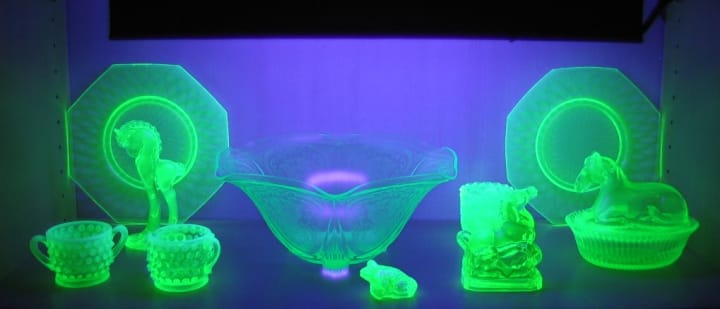
Uranium glass underwent production beginning in the 1830s and continued through the Great Depression. It’s often nicknamed ‘Depression glass’ if manufactured in the late 1920s and throughout the 1930s. Prior to this period, uranium glass produced is usually referred to as ‘Vaseline glass’ or ‘canary glass.’
To the naked eye, there’s also a difference in appearance. Both periods of glass give off a similar green glow under UV light, but Vaseline glass appears yellowish to the naked eye because it resembles the color of petroleum jelly. Depression glass is greener, but also sometimes blue or pink. Though the latter examples more rarely contain uranium ore.
The amount of glow uranium glass gives off depends on the quantity of uranium oxide present. Some pieces may glow dimmer than others while others contain enough uranium that even normal light encourages a very slight glow in typical lighting
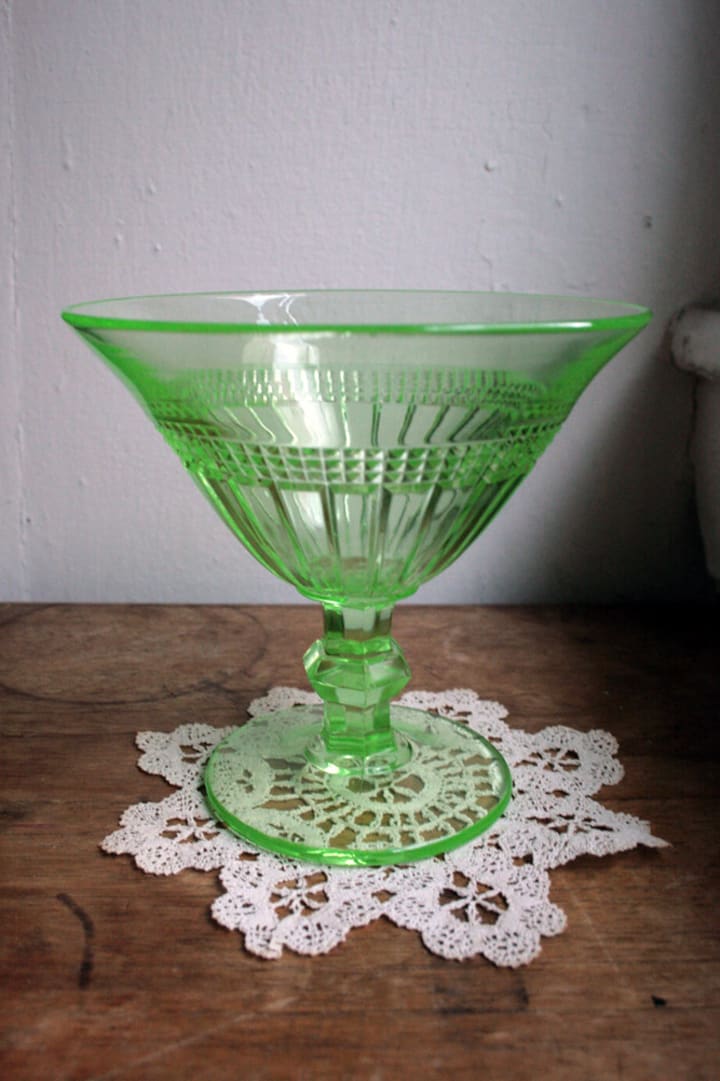
Why Is Antique Glass Radioactive and Is It Dangerous?
During the Great Depression, uranium oxide introduced vibrant color into easily mass-produced, affordable glass. When the United States began experimenting with radioactive materials during World War II for the Manhattan Project, the manufacturing of uranium glass halted for over a decade
To determine the danger of this glass, we need to do some quick math. Let’s round off the above reading in the video to 2.0 uSv per hour for convenience. That means if you were to hypothetically use this glass as a pillow and slept on it for a 24-hour period (sounds comfortable), you’d receive a dose of about 48 microsieverts. There are 1000 microsieverts in 1 milisievert and 1000 milisieverts in 1 sievert. The standard dose to worry about is 1 Sievert, the minimum amount needed to seek medical attention.
One Sievert of radiation is equivalent to one million microsieverts. 1,000,000 microsieverts / 48 microsieverts per day = 20,833 days to incur a high enough dose to require medical attention.
That means it would take roughly 20,800 days of constant exposure to rack up enough of a dosage to be worried about. That’s 57 years’ worth of your continuous, unyielding time. This figure ignores whether or not your body would absorb that radiation, because uranium is primarily an alpha emitter, it wouldn’t.
Pay attention to how close the dosimeter must be to the glass to register any increased radiation. A few inches of air between the glass and the measuring device is enough to alter readings sending the device back to near-normal levels of background radiation.
There are some caveats, for example, the device used may not have given accurate readings and likely is not measuring alpha radiation, but assuming the levels are in the ballpark, they give us a reasonable figure to calculate danger potential.
So to answer the question, no. Uranium glass isn’t dangerous if handled appropriately. Though, if you ingest uranium, this is where it could be problematic. If you were to break this glass, and small pieces flaked off into your skin or glass dust particles were inhaled, it could cause a health risk. This risk increases if regularly exposed to other sources, like plane trips, x-rays, CT scans, and other sources of ionizing radiation.
Since dinnerware and glassware come in contact with foods and drinks we ingest, it may be worth considering the danger. Acidic foods or drinks can break down the glass over time, which might enter your stomach. Though, the amounts we are talking about are insignificant. So realistically, even if you were to use this glass every day, the odds of suffering any health effects from the glass over an entire lifetime are extremely low. It’s just not enough exposure to pose any significant risk to worry about.
But considering this glass is an antique, not microwave friendly, and somewhat fragile, I think it’s best to avoid using it as kitchenware to preserve and protect its history and unique properties.
Where Can I Find It?
People tend not to realize they have uranium glass. Few know to check with blacklights and fewer have devices to measure the radiation these antiques kick out.
Because of this, uranium glass often wastes away on cluttered shelves at estate sales and thrift stores. You’re likely to find them at garage and yard sales in older neighborhoods awaiting an adventurous collector with a handheld blacklight.
For many collectors, hunting uranium glass down is a fun hobby, because you never know what you will find. These pieces often sell for pennies or dollars if you’re lucky enough to find them in these settings.
Many collectors enjoy sifting through vast glass dumps to find old bottles (ideally unbroken) that may include uranium glass as one of the prized finds. Uranium glass and other vintage glass bottles were disposed of in old abandoned dumps. This activity can pose a danger for glass hunters searching through these old dumps because often the glass is broken and sharp.
If you’re not up for the hunt, you can most likely find them at any local antique shop or online. eBay is a good online source for uranium glass. But be prepared to pay a bit more if purchasing in a shop or online. These pieces can be valuable, especially if they are in pristine condition and contain a lot of uranium
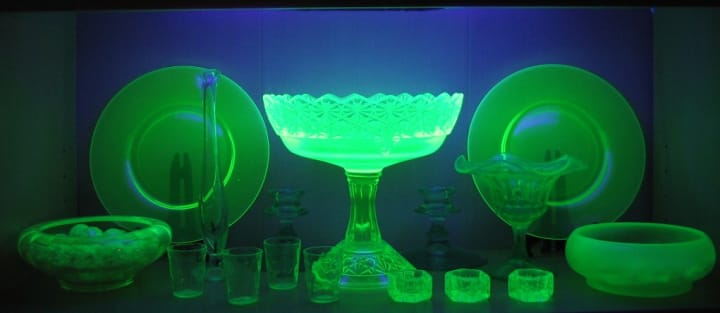
Those who collect uranium glass will often place them in a cabinet lined with blacklights so that the eerie, unmistakable glow of the glass always shines. These displays are striking and are sure to spark an interesting conversation when you have company over.
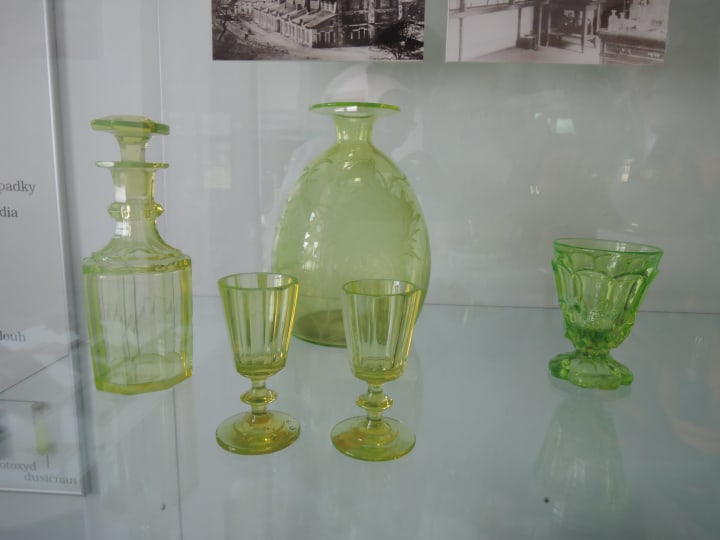
Glass manufacturers didn’t just use uranium for kitchenware. Uranium also found its way into a number of other household objects, including marbles, figurines, oil lamps, vases, ashtrays, salt and pepper shakers, jars, and even jewelry!
The glass can appear opaque, like custard glass, or transparent and in colors like white, green, blue, pink, or yellow. If you have any glass or ceramic antiques, it might be worth checking with a blacklight, because you might have an extra special valuable with display potential.
Uranium in glass produces brilliant coloring effects and is generally safe. So rather than fear these objects and the radiation they contain, enjoy them. These radioactive objects are collectible, historical, and just really damn cool.
About the Creator
David Weis
I am an atheist, liberal, humanist and skeptic. I care about the world and want to change it for the better and hopefully improve societal well-being along the way. I'm interested in science, history and mythology.






Comments
There are no comments for this story
Be the first to respond and start the conversation.